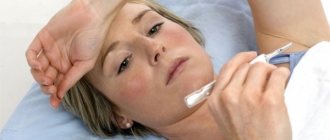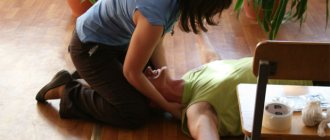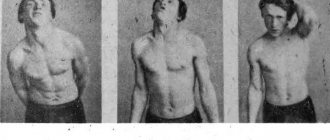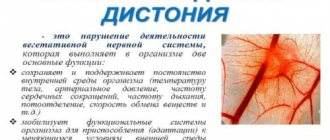Features of the condition Symptoms of VSD VSD - what is it in simple language What should be the treatment How to reduce anxiety during VSD yourself The crisis course of VSD How to behave during an attack Problems that may arise during treatment
“Vegetative vascular dystonia - what is it?” – uninformed patients ask their doctors. To answer this question, imagine the following situation.
A person comes to see a doctor and complains of various symptoms that do not give a clear picture of any disease. The specialist prescribes many tests for the patient to rule out possible diseases. After diagnosis, it turns out that all tests are normal and the person is not sick with anything.
- Do not miss! How to recognize depression in your husband
The doctor is confused, the patient himself is puzzled - if everything is in order, then why are there so many symptoms that interfere with normal daily activities? What is this mysterious imbalance in the functioning of the whole body? It is for such cases that the diagnosis “VSD” was invented.
Features of the disorder
The autonomic nervous system is responsible for the functioning of the heart, blood vessels and other internal organs. With VSD, a malfunction occurs in its functioning, which causes a lot of unpleasant symptoms for a person. In total, more than 40% of people suffer from ANS disorders.
Types and reasons
VSD is divided into several types: hypertensive, hypotonic, vascular, mixed and cardiac. In some cases, other types are distinguished that correspond to the manifestation of symptoms or the degree of impairment. Most often, the disorder develops in adolescents. The basis for its appearance can be:
- Heredity;
- Severe stress, chronic fatigue, mental disorders;
- Diseases of the endocrine system;
- Serious changes in the body due to hormonal changes;
- Brain lesions (TBI, tumors, hemorrhages).
Often it is not possible to determine the real cause of the disorder, but this does not interfere with the main treatment.
Symptoms
VSD manifests itself not only with the usual symptoms that are present in the patient’s daily life, but also with periods of exacerbation, called crises. They can often be confused with a panic attack, because... they go through an attack, during which the amount of adrenaline in the blood sharply increases, which causes a strong surge in the activity of the ANS. The result is a serious failure of the nervous system, which causes various symptoms to appear.
The main symptoms include the following:
- Increased fatigue – a person may become tired after completing the simplest task, even with good rest;
- Feeling of anxiety - the patient thinks that something might happen, he feels anxious, phobias may appear, everything is accompanied by rapid heartbeat;
- Severe sweating - sweat appears even with light physical activity, it can also appear after minor stress without physical activity;
- Increased body temperature - it can increase both during an attack and remain elevated for a long time;
- A feeling of tightness in the chest – the patient may feel pressure on the chest, a feeling of chest compression;
- Heart pain – feels stabbing, dull or squeezing, can occur for several hours in a row, similar to neuralgia;
- Headaches – the patient may have a constant headache, often feeling slightly dizzy;
- Lack of air - a feeling of lack of oxygen; a person may feel as if his throat is constricted, sometimes a “lump” appears;
- Muscle tension – the patient’s muscles are in a tense state, especially often manifested during an attack;
- Numbness of the extremities - can affect the arms or legs, but sometimes occurs only in the fingers;
- Goosebumps – the patient feels as if small goosebumps are running all over him; sensations appear in any part of the body, but are more often concentrated on the head or limbs;
- Problems with the gastrointestinal tract - many people with VSD experience digestive problems, which causes a lot of problems in everyday life;
- Mental disorders - depressive mood, mental stress, lack of desires and motivation.
With VSD during pregnancy, women may develop anemia, which is why the baby does not receive enough oxygen. For this reason, he experiences developmental delays, has a weakened immune system, and regularly has headaches. Sometimes, with dystonia in pregnant women, late toxicosis occurs, and in especially severe cases, bleeding occurs with placental abruption. Men, on the other hand, may experience erectile dysfunction, which makes impotence their main problem.
Vegetative-vascular dystonia is chronic, and the patient gradually begins to get used to its manifestations.
Types of VSD
There is no unified classification of vegetative vascular dystonia. The table shows the classification of VSD depending on disorders of the cardiac and vascular systems.
| VSD type | Description |
| Hypertensive | Blood pressure increases greatly even at rest, and the heart rate increases. There is a state of emotional imbalance, panic attacks occur. |
| Hypotensive | Blood pressure decreases to 100/50 mmHg. The person becomes very lethargic and weak. Shortness of breath appears. The patient feels chills, feels nauseous, and sometimes vomits. |
| Normotensive | Does not depend on blood pressure. The heart rate is slow, there is aching pain in the chest. |
| Mixed | Combines features inherent in several types of VSD. |
Diagnosis and treatment regimen
It is not enough to simply know how to treat VSD. First, you need to conduct a thorough diagnosis to make a final diagnosis, and only then, together with your doctor, draw up a treatment plan. VSD is a very complex disorder that requires a serious approach. It cannot be cured completely; patients can only maintain their condition during a period of remission. And this makes therapy even more important.
Diagnostics
It is very difficult to draw the line between ordinary stress and VSD. Therefore, many people do not even suspect that they have a serious health problem. When visiting a hospital, the doctor’s main task is to make an accurate diagnosis. This task is very difficult, because It will not be possible to detect dystonia using classical examinations or tests.
First, the doctor must find out the details of the patient’s symptoms. On this basis, it will be possible to draw preliminary conclusions. After this, you will need to undergo diagnostics, including:
- ECG;
- EchoECG;
- REG;
- RVG.
Sometimes additional examinations may be required. All this is required in order to exclude other diseases. Therefore, the patient often works not only with a specialist in the field of neurology, but also with an ophthalmologist, otolaryngologist, endocrinologist, cardiologist and psychiatrist.
When all pathologies corresponding to the symptoms are excluded, the doctor will diagnose VSD. Additionally, it will be necessary to determine the root cause in order to treat it and eliminate further complications. If this cannot be done, then therapy is completely aimed at eliminating symptoms and preventing the development of VSD.
Treatment regimen
Immediately after the diagnosis is made, the doctor works out a future treatment plan. If a serious underlying cause of dystonia is discovered that requires medical intervention, the patient is prescribed special medications that could affect it. The basis of therapy is always suppression of VSD symptoms.
It will not be possible to achieve results by taking medications. Therapy must be comprehensive. For this the patient will need:
- Nutrition correction;
- Physical activity;
- Psychotherapy;
- Physiotherapy;
- Drug treatment;
- Folk remedies.
Treatment is carried out at home. Placing a patient in a hospital makes sense only in severe cases when his condition requires medical supervision.
Nutrition
Nutrition correction is the most important component of the treatment of VSD. With a mild degree of disorder, diet is enough to completely normalize your condition without taking any pills. Diet restrictions are not so strict, because... they are aimed at balancing nutrients and eliminating junk foods.
It is enough to adhere to the following rules:
- Minimize salt intake. It is advisable to cook food without adding it or reduce its quantity to extremely small volumes.
- Give up coffee. If you drink coffee, then surges in blood pressure will be inevitable. This should be avoided in case of VSD.
- Stop drinking alcohol. Any alcoholic drinks are extremely harmful to the body. They contribute to the strengthening of the ANS disorder.
- Eliminate fatty, smoked, spicy, and fast food from your diet. Such food puts a lot of stress on the digestive organs, which fuels dystonia.
- Reduce your consumption of sweets. Any sweet foods are very harmful to the human body. Especially for those who suffer from VSD.
- Stop eating processed and canned foods. The increased content of chemical additives in such products has a negative effect on the entire body.
- Increase the consumption of foods rich in vitamin B. It suppresses the manifestation of VSD. You need to eat fish, meat, grains, vegetables, fruits and dairy.
- Include fiber-rich foods in your diet. You should eat seaweed, bran, any legumes or nuts.
- Expand your diet with foods containing potassium. Buckwheat, oatmeal, parsley, lettuce, carrots, apricots - they are very rich in potassium and other useful minerals.
- Drink water. Dehydration of the body contributes to increased VSD. Therefore, it is important to monitor the amount of liquid you drink - you need to drink about 2 liters daily.
If these rules are followed, the patient will feel better, and the risk of developing various pathologies will be significantly reduced.
A slightly different diet will be for hypotonic type VSD. It is accompanied by low blood pressure, which requires a special diet. The following rules must be followed:
- Eat small meals 5 times a day at three-hour intervals.
- Avoid fasting days. Never leave your body hungry.
- Add natural coffee, green tea and milk to your diet.
- Drink freshly squeezed citrus or blackcurrant juices.
- Supplement dishes with ginger, cinnamon, pepper, and herbs.
It is recommended to monitor your diet even after the symptoms disappear and the attacks stop. This is the only way to maintain your normal condition.
Treatment of vegetative-vascular dystonia (VSD)
Treatment of vegetative-vascular dystonia is a rather lengthy and painstaking task.
A positive prognosis largely depends on correct diagnosis and accurate determination of the cause of VSD. Treatment of VSD is carried out comprehensively and includes the following points:
- Normalization of daily routine, sleep, rest;
- Elimination of physical inactivity using dosed physical activity (PT);
- Therapeutic massage and water procedures;
- Balneotherapy (treatment with mineral waters);
- Phototherapy;
- Limiting sources of emotional experiences - computer games, TV shows;
- Counseling and family psychological correction;
- Normalization of nutrition (regular consumption of food enriched with vitamins);
- Electrophoresis;
- Drug therapy.
Read also Sphenoiditis. Symptoms, causes, types and treatment of sphenoiditis
Work/rest mode
Each person’s body has its own specific “charge”, which depends on many factors. When the strength runs out, but a person continues to overload his body with physical or mental work, the body begins to weaken, thereby being subject to various imbalances in the functioning of certain systems. The same thing happens if a person does not give the body enough time to rest. Therefore, to maintain health, it is very important that a person maintains a work/rest schedule. Work in moderation, rest and be sure to get enough sleep.
Physical inactivity or sedentary lifestyle
A sedentary lifestyle leads to weakening of the muscle tissue of certain organs that are least involved in a person’s daily life. In addition, physical inactivity increases the risk of developing various diseases of the cardiovascular system. “Movement is life”, this is a fair saying. The more a person moves, the better the blood “plays”, thereby improving blood circulation, the organs receive with the blood the nutrition necessary for their normal functioning in the form of oxygen and various substances.
Therapeutic massage and water treatments
Physical effects on the body, in particular therapeutic massage and water procedures, improve blood circulation, improve the functioning of the lymphatic system, if necessary, restore the structure of the spine (in the case of osteochondrosis), and along with the spine, the nerve channels with the vessels that pass through it are aligned. In addition, massage allows you to relax, relieve stress, and improve muscle tone. All these actions have a beneficial effect not only on the functioning of the central nervous system, but can also improve the overall health of a person.
Sources of emotional experiences
The modern number of media, as well as ways to obtain this information, is only growing from year to year. Today, few people will be surprised by a smartphone with the ability to get information from the Internet, a computer, a laptop, or a TV. But the whole problem lies in the quality of the information received. If you make a short review of at least posters for certain modern computer games, some cartoons, movies, news, then you can highlight the overall picture - murder, violence, cruelty, lies, wars, the occult, etc. All this has an extremely negative impact on the developing psyche of the child, and on many people as well. Bad dreams, selfishness, disrespectful attitude towards other people are just the tip of the iceberg. The basis is emotional instability, imbalance, uncertainty about the future, panic fears. If you are a parent and have not yet studied the flow of information that feeds your child, this is the time to start doing so. Protect your child from the negative flow of information from the Internet and other sources. This is a very important point not only from a therapeutic VSD point of view, but also as a preventive measure against other complex diseases that usually manifest themselves in an adult.
Family psychological correction
This measure is necessary if your family experiences frequent conflicts and difficulties raising a child. Remember, quarrels and scandals have a negative impact on the mental development of a child. Do not allow a showdown in front of the children. Children should grow up in a loving family where each member respects each other. In this way, a person is cultivated who will follow your family model, and it is better for the family to be happy.
Nutrition
For the normal functioning of any human organ or system, various vitamins and minerals are required. Each vitamin is involved not only in the functioning of the entire body, but also in the development of all organs and regulation of their vital functions.
Some of the vitamins are produced in the required quantities by the body itself, but basically, we can only get vitamins from the food we eat. If a person gets used to eating fast food, sandwiches, chips, beer and other low-health foods, he does not receive the required amount of vitamins, because These foods simply don’t contain them. It's tasty, perhaps, but it's certainly not healthy. Moreover, such junk food is harmful to human health. It is also extremely important to eat at least 3 times a day. Food is a kind of “energy” that is necessary for a person to perform various daily tasks. There is no food, or it is incomplete, there is no strength for work, and of course, human health.
Give preference to foods rich in vitamins and minerals - vegetables, fruits, herbs, cereals. Try not to fry foods, but to steam or boil them. The less you heat treat your food, the more vitamins and microelements they will retain. Human beauty and health largely depend on human nutrition.
Electrophoresis
For vagotonia, electrophoresis with caffeine, calcium, and mesatone is prescribed. For sympathicotonia, electrophoresis with magnesium, papaverine, bromine, aminophylline is prescribed.
Drug therapy
Drug therapy is usually used in the following cases:
- Non-drug therapy did not bring the desired result;
- To relieve various kinds of symptoms that make it difficult to perform daily tasks;
- For the treatment of various chronic diseases that may be factors determining the development of VSD.
Medicines for VSD:
Sedatives. They have a beneficial effect on the nervous system and calm. Among the sedatives widely used: preparations based on valerian, hawthorn, St. John's wort, motherwort - "Novopassit", "Persen", "Stressplant", herbal tea with lemon balm.
Tranquilizers (anxiolytic drugs). Used to relieve attacks of fear, stress, and anxiety. Among the tranquilizers you can find Relanium and Tranxen.
Antidepressants. They are used to relieve feelings of depression, depression, apathy, anxiety, irritability, emotional stress, as well as to increase mental activity. In addition, antidepressants are used in cases where a patient with VSD constantly feels aches and pains throughout the body (in the heart, gastrointestinal tract, muscles and joints), which are not amenable to symptomatic treatment. Antidepressants include: Amitriptyline, Imipramine, Clomipramine, Coaxil, Prozac, Cipramil.
Read also Pleurisy - symptoms, causes, types and treatment of pleurisy
Nootropics. They are used to improve mental activity, brain resistance to various stressful situations, and improve the energy state of neurons. Among the nootropics we can highlight: “Pyritinol”, “Piracetam”, “Phenibut”.
To normalize peripheral and cerebral circulation, as well as blood microcirculation, the following are used : Cinnarizine, vinpocetine (Cavinton), pentoxifylline (Trental), nicotinic acid (vitamin B3 or PP).
For sympathicotonia and pain in the heart area, beta-blockers are used - propranolol (Anaprilin, Obzidan), Atenolol (Atenol, Tenormin).
To relieve heart pain, the following is used: Verapamil (“Verapamil”, “Isoptin”), “Valocordin”, valerian tincture.
With vagotonic reactions. Psychostimulants of plant origin are used - preparations based on Schisandra, Eleutherococcus, Zamanikha, etc.
For intracranial hypertension (high blood pressure), dehydration therapy is used, which is aimed at removing excess water from the body. Diuretics are used for these purposes.
In combination, glycine, glutamic acid, pantogam, and complexes of vitamins and microelements have proven beneficial in the treatment of VSD.
For constipation, you need to add food with plenty of fiber, fresh vegetables and fruits to your diet. It is also allowed to take laxatives: Duphalac, Lavacol, Normaze.
With frequent diarrhea , the amount of fiber consumed in food must be reduced. Additionally, you can take an antidiarrheal agent: loperamide (Imodium, Lopedium), sorbents (Polifepan, Smecta).
At elevated temperatures, you can take: “Pirroxan”, “Phentolamine”.
In case of increased sweating , the skin can be treated with solutions of formaldehyde, potassium permanganate (potassium permanganate), tannic acid.
In case of venous insufficiency - if the patient has noise in the head and throbbing pain in it, heaviness in the head, you can take: "Vasoket", "Detralex". Medicines for venous insufficiency are taken for 1-2 months.
For dizziness due to high blood pressure, drugs that improve cerebral circulation are used - Vinpocetine, Cavinton, Nicerium, Oxybral.
For severe headaches and dizziness, you can take Betaserc.
Important! During treatment for VSD, be sure to give up bad habits - smoking, drinking alcoholic beverages, taking drugs.
Forecast
With timely detection, accurate diagnosis and strict adherence to the doctor’s instructions for the treatment of VSD, the prognosis for recovery is favorable. In case of VSD, it is very important to correctly carry out psychological adjustment of the child, so that after he grows up, the mental deviations formed during VSD do not accompany him throughout his life.
Physical activity
Another way to treat VSD is physical activity. Even short workouts have a positive effect on the health of the heart and blood vessels, as well as the functioning of the respiratory system. However, it is very important to start exercising gradually, without overloading your body. Therefore, you should not suddenly perform complex exercises or devote a lot of time to sports.
It is best to start with short walks in the fresh air. Gradually the duration and speed need to be increased. Later, when the body is ready, you can go in for regular sports. At the same time, walks should still be left as an obligatory part of everyday life, because... they are always helpful. You shouldn’t give up morning exercises either. It helps improve well-being, increase vigor and lift your mood throughout the day.
It is recommended to give preference to simple sports. For the first training sessions, it is worth hiring a personal trainer, if possible. It will help you correctly distribute the load on the body, and also teach you how to exercise correctly. This is true for almost all types of sports training.
What types of physical activity should you include in your life:
- Swimming. One of the most useful sports that strengthens almost all body systems. It helps to overcome dystonia, get rid of nervous tension, calm the psyche, improve muscle condition, and strengthen joints.
- Cycling. The main benefit of cycling training is good oxygen saturation of the body. Also, after them, blood pressure normalizes, the immune system is strengthened, and muscle tone increases.
- Race walking. You can do it with virtually no preparation. It helps develop muscles, saturate the brain with oxygen, and also has a positive effect on the cardiovascular system.
- Yoga. When practicing yoga, the human body completely relaxes, which calms the nervous system, normalizes the psycho-emotional state, and also improves respiratory functions.
- Physiotherapy. A special set of gymnastic exercises is compiled by the attending physician. The patient who performs them already feels positive changes in his well-being within a few days.
Additionally, you should pay attention to breathing exercises, because... it is very effective against dystonia.
After consultation with a doctor, participation in team sports (basketball, volleyball), as well as skating or skiing, is allowed. They are no less useful for the patient, and such sports have their advantages. But you can't do football, boxing or weightlifting. It is also not recommended to go jogging, because... it puts a serious strain on the body. This is especially true for VSD of the hypertensive type, in which even during simple physical activity you need to monitor your blood pressure.
It is recommended to complete any workout with a contrast shower, which is very useful for every person.
What is vegetative-vascular dystonia?
Vegetative-vascular dystonia (VSD) is a complex of various clinical manifestations that develop as a result of impaired functionality of the autonomic nervous system of certain organs (mainly the heart and blood vessels) and body systems.
Other names for VSD are autonomic dysfunction, neurocirculatory dystonia (NCD) .
How does the autonomic nervous system work?
To make it easier to understand this concept, it should be noted that the autonomic nervous system (ANS) is an autonomous part of the body’s nervous system, the center of which is located along the spine. The ANS consists of 2 conditioned mechanisms (divisions) that control the functioning of organs - sympathetic and parasympathetic. Both sections of the ANS, thanks to the presence of nerve cells in each organ and system, regulate their functionality, for example, causing the urge to defecate or urinate, feelings of hunger, nausea, increased or slow heartbeat, increased or decreased blood pressure, desire to sleep or lack of sleep, respiratory processes, production of insulin, adrenaline, serotonin, etc.
The sympathetic department is responsible for the activation of all processes, and the parasympathetic department is responsible for the relaxation or rest of certain organs.
How it works? A person is hungry, a signal goes to the autonomic nervous system, the person eats food, and the receptors again report this to the ANS, which sends a signal to the pancreas, which produces the juice necessary for processing food. After the required portion of juice, when the food is processed, the stomach reports this to the ANS, and it “talks” to the pancreas, which stops the production of juice, then as food passes through the gastrointestinal tract, the whole process is regulated, ending with the urge to defecate. Thus, the autonomic nervous system constantly regulates the work of the entire organism as a whole, either activating or deactivating the work of each organ, automatically. Thanks to these mechanisms, a person does not need to think about how to breathe, or produce pancreatic juice, or increase body temperature if an infection has gotten inside, how to raise an arm or bend a leg, dilate the pupil in the dark or constrict in bright light, etc.
When, due to various pathological factors, a malfunction of the autonomic nervous system occurs, the balance between the sympathetic and parasympathetic sections of the ANS is disrupted, a person feels various kinds of symptoms, and at the level or organ where the disturbance occurred. It is important to note that the organ may not actually be sick, only its connection with the nervous system is lost, and therefore the normal functioning of the organ/system is disrupted.
Thus, in simple terms, vegetative-vascular dystonia is a collective name for various clinical manifestations (symptoms) that arise due to a disruption in the functioning of the central and/or peripheral parts of the autonomic nervous system (ANS). Moreover, you need to understand that, for example, high blood pressure during VSD is not associated with hypertension, but manifests itself due to a disruption in the functioning of the autonomic nervous system at the level of the cardiovascular system, just like heart pain. But, if VSD is not treated and due attention is not given, it can lead to real diseases of certain organs - coronary heart disease (CHD), hypertension, and other diseases of certain organs/systems.
Doctors note that vegetative-vascular dystonia is most often observed in children (25-80%), most often at the age of 7-8 years or adolescents, mostly female, and in urban environments. This age falls precisely on transitional periods, possibly stressful ones, when a child moves from kindergarten to the first grade of school, as well as graduation from school and studies in higher educational institutions. VSD is increasingly common in adults, which is also due to modern, often negative news in the media, as well as the often unpredictable “tomorrow”.
VSD. History and modernity
It is impossible not to mention an interesting fact, which perhaps many people do not know, that the diagnosis of VSD, in fact, was made only to residents of the USSR, although today some doctors use it. This is evidenced by the absence of this disease in the international classification of diseases (ICD-10), because This kind of disease does not exist in Europe and America.
Psychotherapy
Working with a psychotherapist is very important in the treatment of dystonia. Often, a disorder of the nervous system is caused by a psychological factor. Even if the root cause is different, then in many people dystonia is fueled precisely by the psycho-emotional mood of the patient. It is important to eliminate all of these factors that may have caused or contributed to the problem. Therefore, working with a specialist is an integral part of general therapy.
The task of the psychotherapist is not simply to eliminate psychological factors. He must change the patient's train of thought so that he can realize his real problem. In most cases, patients do not attach any importance to mental components at all. This is exactly what the doctor must correct. To understand and eliminate mental disorders, the following can be used:
- Method of suggestion;
- Auto-trainings;
- Psychoanalysis;
- Art therapy;
- Behavioral therapy.
Sometimes less common methods of psychotherapy are used. But almost always only one method is used to achieve a goal. Its choice depends on the individual characteristics of the patient and the course of dystonia.
An additional task for the doctor is to try to convince the patient to become involved with his environment. To do this, you need to surround yourself with positivity, allocate enough time for proper rest, regularly be in nature, and find an interesting hobby.
Changing your attitude towards stress
Patients are not recommended to worry... In this they are no different from all other people - with or without diagnoses. The question is that for patients with VSD, stress can become a direct source of crisis, and constant stay in an environment that puts a lot of stress on the psyche does not bring any benefit. Especially when you consider that VSD makes people the most vulnerable and unable to tolerate aggression, moral pressure and similar influences. The advice about avoiding this is very clever. True, advisers will never tell you how to get into an environment of harmony and mutual love.
It is necessary to change the attitude towards stress, because it is contraindicated to worry, worry and worry during VSD
It is necessary not to avoid stress, since this is simply impossible, but to learn to react differently to traumatic situations. In some ways, such training is already a method of psychotherapy and one of the types of healing. Auto-training exercises are suitable; it is worth reading Mikhail Litvak’s book “Psychological Aikido”. You need to have several breathing techniques in stock that will promote relaxation and establish emotional balance.
The best way to deal with stress is to artificially create a situation that causes it and gently control everything that happens. Where does stress most often occur, and in what cases? Maybe it's a line in a store or a meeting with someone. Try to find yourself in similar situations again and manage them in your own way. “Extinguish” outbursts of emotions with the help of breathing exercises and developing the ability to “pass” aggression through yourself without becoming completely involved in the process.
Worth seeing: Afobazole for VSD
Physiotherapy
Treatment of VSD using physiotherapeutic procedures shows the highest effectiveness. Therefore, they have become widespread and are used for almost every patient. They are based on the effects of water, heat, light or certain substances that have a physical effect on the human body. Such methods are used in a hospital setting, but patients undergoing outpatient treatment can independently visit the clinic where they will undergo physical therapy.
The following methods are most effective:
- Electrophoresis with the addition of special substances (bromine, magnesium, lidocaine, etc.);
- Massage;
- Magnetotherapy;
- Electrosleep;
- Thermal procedures;
- Galvanization;
- Baths (coniferous, sulphide, carbon dioxide, dry air, pearl);
- Mud therapy;
- Acupuncture.
In some cases, physiotherapeutic treatment is enough to completely relieve symptoms, which is why it is not even necessary to get rid of VSD with the help of medications. This is only possible if the described procedures are carried out regularly. Before visiting them, you should definitely consult with your doctor, because... sometimes they may turn out to be ineffective and even useless.
Spa treatment can make a significant contribution to the fight against dystonia. There, patients can take advantage of a large number of different physiotherapeutic procedures that will relieve them of unpleasant symptoms. An additional effect is provided by a sharp change of environment, combined with good physical and psychological rest.
Causes of VSD
It is impossible to establish the cause of the disease without a direct understanding of what dystonia is. If we consider it not as a disease, but as a consequence of a number of physical and psychological causes, the range of areas in which one can find the “root of evil” that provoked the discord expands.
Types of manifestations of VSD can easily be mistaken for emotional instability, a poor state of the nervous system (in the understanding of socially inappropriate behavior), or even for the inventions of a hypochondriac. Unfortunately, insufficient attention to even simple emotional stress can over time turn into an alarming manifestation of vegetative-vascular dystonia.
The reasons leading to the development of autonomic disorders can be:
- Hereditary predisposition.
- Fetal development disorders due to difficult pregnancy.
- Abnormal birth, diseases and infections suffered in early childhood.
- Congenital malformations of internal organs, pathologies.
- Suffered traumatic brain injuries.
- Hormonal imbalance, disruption of the endocrine system (chronic or experienced during adolescence, as well as during pregnancy).
- Prolonged stress, physical and psychological.
- Past psychological trauma, stress, depression, depression and other emotional disorders.
Often, signs of VSD may not appear for the time being or may not cause noticeable trouble until the onset of a vegetative crisis. This means an exacerbation of the condition, when previously “dormant” symptoms suddenly appear and are extremely difficult for the patient to experience. The crisis is characterized by seasonal fluctuations (the notorious “autumn depression” is not so groundless) and leads to a number of difficulties both in the usual daily routine (impaired appetite, sleep patterns and performance), and in any interaction with others (irritability, anxiety, inability to concentrate and increased attention to the slightest changes in one’s own state).
Drug treatment
Therapy for VSD involves taking medications. With a mild degree of the disorder, there is a chance to be cured even without them, but with severe dystonia, medications are a prerequisite for recovery. The list of medications that are prescribed to patients with VSD is very large. This is due to the fact that it is often necessary to influence a large number of body systems, producing different effects. The doctor will tell you immediately after the examination how to treat vegetative-vascular dystonia.
Patients are prescribed medications of the following groups:
- Adaptogens (“Ashwagandha”, “Leuzea”). Tones blood vessels, increases stress resistance of the nervous system.
- Anticholinesterase (“Neuromidin”). Stimulate the functioning of nerve tissues, improve brain functioning, and normalize the condition of muscle fibers.
- Mild sedatives (Valerian, Motherwort, Corvalol, Novo-Passit). Normalize the patient's mental state.
- Tranquilizers (Gidazepam, Afobazol, Phenazepam, Diazepam). Relieves feelings of anxiety and tension.
- Antidepressants (Prozac, Cymbalta, Sydnofen). Improves mood and reduces depression.
- Sleeping pills (“Donormil”, “Zopiclone”, “Dormikum”). Improves sleep quality and has a calming effect.
- Nootropics (“Piracetam”, “Noofen”). They relieve headaches, weakness, dizziness, tinnitus, and have a positive effect on the brain.
- Neuroleptics (Ridazine, Risperidone, Thioril). Reduce aggression, irritability, nervousness, increase vascular tone.
- Improving blood circulation (“Stugeron”, “Cavinton”). They normalize blood circulation in the body and have a positive effect on blood vessels.
- Antihypertensives (“Atenolol”, “Anaprilin”, “Lasix”). Reduce arterial or intracranial pressure, effective for hypertensive VSD.
- Hypertensive (Mezaton, tincture of lemongrass or ginseng). Helps increase blood pressure in hypotonic dystonia.
- Medicines for the heart (“Riboxin”, “Panangin”). Eliminate heart pain, normalize heartbeat.
- Antioxidants (Kratal, Mexidol). Protect brain cells and normalize the general condition of the body.
- Vegetotropic (“Bellaspon”, “Platifillin”). Normalize mental state, improve mood, relieve pain with sweating.
- Vitamin complexes (“Neuromultivit”, “Neurorubin”). Restore nerve tissue and relieve pain.
Doctors prescribe only a few groups of drugs, because... simultaneous use of all medications can seriously harm the patient’s body. After taking some medications, you will need to start being treated with others. Your doctor will give you precise instructions on the order of use of medications.
It is important to strictly adhere to medical recommendations so as not to harm your health. If you skip medications or increase the dosage yourself, the effectiveness of treatment will decrease and the risk of complications will increase.
Traditional methods
You can supplement the main therapy for VSD with folk remedies. They will help eliminate symptoms, normalize the condition, and also maintain the remission stage of the disorder. They should be used with caution, because... sometimes they may not be combined with drug treatment.
The most effective ways to use the following are:
- Herbal collection. It uses lespedeza, chamomile, mint, peony, motherwort, valerian, and lemon balm. All herbs should be mixed in equal quantities, take 10 g from the mixture, pour 250 ml of boiling water, close, let it brew for about 8 hours, and then strain. You need to drink 100 ml in the morning, afternoon and evening. This infusion strengthens the nervous system and also tones the entire body.
- Pine nut tincture. To prepare, you need to pour a small amount of nuts with hot water (100 ml), let them brew, and then strain the infusion through cheesecloth. You can drink it one spoon three times a day or add one spoon per glass to the herbal tea. The product helps to improve the condition of the nervous system, eliminate pain, increase stress resistance, and normalize sleep.
- A mixture of plants and honey. The recipe requires mixing 100 g of crushed rose hips, birch buds, chamomile, St. John's wort, elecampane root, which must be poured with 300 ml of boiling water, while keeping the mixture on the fire for about a minute. After preparation, add a little honey and stir the future drink. You need to drink the product on an empty stomach in the morning, and also before bed after eating. This mixture is very effective against symptoms of dystonia of any type.
- Drops from pharmaceutical tinctures. You need to mix tinctures of valerian, corvalol, hawthorn and motherwort. To use, dilute 80 ml of water with 15 drops of the mixture. Take in the morning on an empty stomach, and also in the evening before bed. Have a sedative effect.
- Mustard. You need to dilute 5 tablespoons of dry mustard in a glass of warm water, and then add the mixture to a regular bath filled with hot water. You should lie in it for about 5 minutes before going to bed. Easily relieves headaches and also improves sleep quality.
Additionally, you can use adonis spring, anise or juniper fruits. All of them will help cope with the unpleasant symptoms of vegetative-vascular dystonia at home.
Treatment methods for VSD
If vegetative-vascular dystonia is not a strictly classified disease, who prescribes its treatment and how? A floating complex of variable symptoms can be successfully diagnosed by both a neurologist and a psychotherapist. The latter will be obliged to send the patient to make sure that the symptoms shown are not the result of other diseases - for example, the cardiovascular or digestive systems. However, if VSD is already registered in your medical history, the course of treatment will be announced by any specialist and at first glance will seem completely obvious.
- healthy lifestyle
The golden rule for the harmonious functioning of all vegetative systems is a healthy lifestyle. It sounds easy, but it’s not so easy to do: for many, giving up smoking, drinking alcohol and caffeine becomes a serious psychological obstacle and even a form of stress, and stress is what initially forms the basis for the formation of this disease.
- Diet
When autonomic dysfunction is manifested by disorders of the digestive system, consultation with a gastroenterologist may be required. Depending on the situation, it is possible to regulate the diet, avoiding excessively salty and spicy foods, flour and fatty foods, coffee and the aforementioned alcohol in any quantities.
- Daily regime
A sedentary lifestyle, hard work and a disrupted daily routine in an isolated space are the worst ways to survive an exacerbation of VSD. If you have symptoms such as insomnia, panic attacks in the middle of the night and fatigue, you should not indulge their development. The body must be reaccustomed to the established hours of sleep and the necessary rest, balancedly alternating with a small load. For example, the regular fear of missing a deadline and exhausting mental work worsen physical condition no less than lack of sleep and seasonal vitamin deficiency.
- Balance of physical and psychological stress
The word “rest” can also become synonymous with “treatment” if its potential capabilities are correctly assessed. The flow of negative information perceived through the media, news feeds and other ways to brighten up leisure time adds to the psychological burden. Fresh air, walking before bed, any set of physical exercises (from gym fitness to home yoga) will help stabilize your condition.
- Physiotherapy
If for one reason or another it is impossible to achieve a state of relaxation at home, sanatorium-resort treatment is also recommended. Staying in the fresh air, water procedures of any type, massages, acupuncture and other therapeutic procedures are aimed at relaxing the body, relieving stress, changing the usual lifestyle and routine experience (usually negative, which becomes a powerful irritant in itself).
- Drug treatment
This method is used with caution and is aimed at improving the effect rather than eliminating the cause. The exception is cases when autonomic disorders develop due to another disease, for example, heart failure. In this situation, additional medications are prescribed by a cardiologist.
To understand how to treat VSD, you should remember: most often its symptoms are multifunctional and interchangeable. Thus, Valocordin and sleeping pills can create a temporary appearance of solving the problem of heart pain and sleep disorders - until the next time, when the imbalance in the mechanisms of the nervous system appears in a new guise.
The most common medications prescribed for VSD are:
- Antidepressants;
- Tranquilizers;
- Herbal preparations (herbal mixtures, tinctures).
They are aimed at helping the patient in particularly advanced cases, when a mentally depressed state with prolonged depression, muscle spasms, etc. seriously complicates life and does not allow turning to other self-help mechanisms.
It is important to remember that there is no direct cure for VSD, which means that life-saving pills in blisters will be aimed at alleviating the general condition and eliminating the consequences, but not the causes. Any medication intake must be agreed upon with the consulting neurologist!
But even an exemplary healthy lifestyle of a vegetarian bodybuilder will not eliminate the consequences if the root of the problem lies in an unresolved life situation that suppresses the emotional background, giving rise to uncertainty, anxiety, self-criticism, and chronic irritability. Family dramas, the consequences of psychological trauma, and personal experiences associated with a transitional/midlife crisis or professional failures can be to blame.
In this case, therapy with a qualified psychologist will not only speed up the effectiveness of the “rest treatment”, but will also eliminate most of the symptoms that arise. Reclusion, self-examination and fixation on the external expression of symptoms of the disease only aggravate the situation, but, paradoxically, are the most common attempt by the patient to help himself.
It would seem logical: sudden crises reduce efficiency, concentration, increase fatigue and make any social interaction painful - which means you need to protect yourself from this until it “burns out”, calms down and somehow goes away on its own. But, alas, isolation can only worsen the condition.
Finding a psychological problem, talking about it, finding safe and consistent solutions is the only option to pull out the weed by the roots, while at the same time helping the body cope with its processes, which have taken the form of vegetative disorders.
Prevention
To consolidate the effect of treatment or reduce the risk of developing VSD in healthy people, preventive measures can be taken. They help to improve the general condition of any person.
You need to remember the following rules:
- Get enough physical activity;
- Be in the fresh air more often;
- Allocate more time for rest;
- Sleep at least 8 hours;
- To refuse from bad habits;
- Try to eliminate all stress from life;
- Watch your diet.
These simple rules can have a huge impact on a person's life. They should be supplemented with doctor’s advice, which will also help reduce the impact of vegetative-vascular dystonia on the body.
What is a dangerous condition with VSD?
Nervous disorders significantly aggravate the course of the disease, negatively affecting the patient’s quality of life. During an exacerbation of VSD, stress provokes attacks in a person, which are manifested by the following symptoms:
- tremor;
- panic attacks;
- sudden changes in temperature;
- tachycardia, arrhythmia, blood pressure changes;
- muscle spasms;
- dizziness;
- increased sweat production.
In some situations, the patient is bothered by gastrointestinal disorders and frequent painful urination. Since vegetative-vascular dystonia can signal the onset of the development of serious abnormalities in the human vital system, it is necessary to seek medical advice and undergo diagnostics.











